
Althaea officinalis, the marsh mallow or marshmallow, is a species of flowering plant indigenous to Europe, Western Asia and North Africa, which is used in herbalism and as an ornamental plant. A confection made from the root since ancient Egyptian times evolved into today's marshmallow treat, but most modern marshmallow treats no longer contain any marsh-mallow root.

Pachypodium brevicaule is a species of plant that belongs to the family Apocynaceae.

Lansium parasiticum, commonly known as langsat, is a species of tree in the family Meliaceae with commercially cultivated edible fruits. The species is native to Southeast Asia. Despite its name, it is not parasitic; the specific epithet parasiticum derives from the fact that it can grow as an epiphyte in the wild, which was once thought to be an indication of parasitism.

Cardamine hirsuta, commonly called hairy bittercress, is an annual or biennial species of plant in the family Brassicaceae, and is edible as a salad green. It is common in moist areas around the world.

Salpichroa origanifolia is a species of flowering plant in the nightshade family known by the common names lily of the valley vine, pampas lily-of-the-valley or cock's-eggs.

Emilia sonchifolia, also known as lilac tasselflower or cupid's shaving brush, is a tropical flowering species of tasselflower in the sunflower family. It is widespread in tropical regions around the world, apparently native to Asia and naturalized in Africa, Australia, the Americas, and various oceanic islands.

Bougainvillea glabra, the lesser bougainvillea or paperflower, is the most common species of bougainvillea used for bonsai. The epithet 'glabra' comes from Latin and means "bald".

Gluta travancorica is a species of plant in the family Anacardiaceae. It is endemic to the southern Western Ghats in India.

Sicyos angulatus, the oneseed bur cucumber or star-cucumber is an annual vine in the gourd family, Cucurbitaceae, native to eastern North America. The plant forms mats or climbs using tendrils. The leaves are palmately veined and lobed, the flowers are green to yellowish green, and the fruits form clusters of very small pepos.
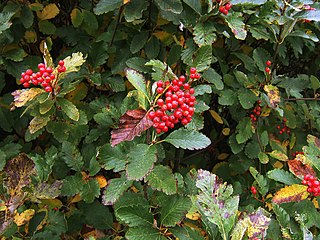
Sorbus mougeotii, the Vosges whitebeam or Mougeot's whitebeam, is a species of whitebeam native to the mountains of central and western Europe from the Pyrenees east through the Alps to Austria, and north to the Vosges Mountains.

Brunfelsia pauciflora is a species of flowering plant in the family Solanaceae, the nightshades. It is endemic to Brazil, and it is grown in cultivation. A shrubby perennial plant grown in gardens, its common names include today, tomorrow together, yesterday, today and tomorrow, morning-noon-and-night, kiss me quick, and Brazil raintree.

Cardiospermum halicacabum, known as the lesser balloon vine, balloon plant or love in a puff, is a climbing plant widely distributed across tropical and subtropical areas of Africa, Australia, and North America that is often found as a weed along roads and rivers.
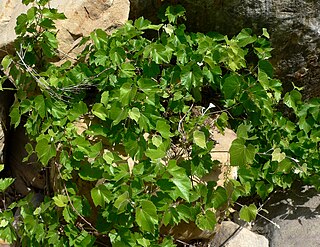
Vitis arizonica is a North American species of wild grape. It is a deciduous vine.

Dillwynia floribunda is a species of flowering plant in the family Fabaceae and is endemic to eastern Australia. It is an erect shrub with hairy stems, crowded, grooved, linear leaves and yellow flowers with red markings.
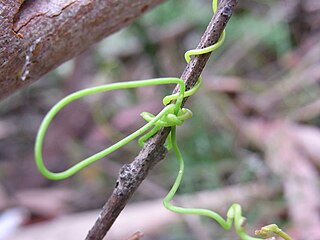
Cassytha glabella, commonly known as the slender devil's twine, is a common twining plant of the Laurel family, found in many of the moister parts of Australia. A hemi-parasitic climber. The specific epithet glabella is from Latin, referring to the lack of hairs. The fruit are sweet and mucousy to taste. The Devil's Twine and Cassytha melantha are similar, but with thicker hairier stems.
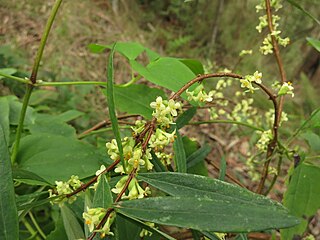
Pimelea axiflora, commonly known as bootlace bush, is a small shrub in the family Thymelaeaceae and is endemic to Australia. It is a small shrub with whitish flowers on mostly smooth stems.

Lonicera acuminata, commonly known as fragrant grove honeysuckle or vine honeysuckle, is a plant species of honeysuckle native to China to Southeast Asia and India.

Euphorbia nivulia is a subtropical succulent species of flowering plant in the family Euphorbiaceae. It is found in the Indian subcontinent and is commonly known as the leafy milk hedge, holy milk hedge or dog's tongue.
Gentiana bredboensis commonly known as Bredbo gentian, is a flowering plant in the family Gentianaceae and is endemic to New South Wales. It is a small annual herb with white flowers.
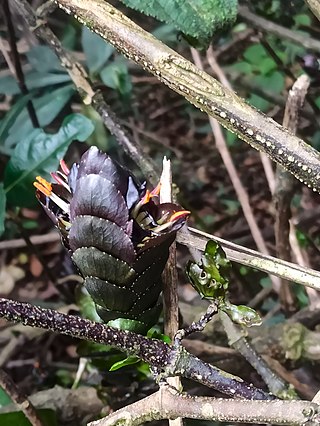
Strobilanthes lurida is a species of flowering plant, endemic to Southern Western Ghats.



















